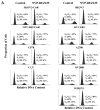Dual targeting of phosphoinositide 3-kinase and mammalian target of rapamycin using NVP-BEZ235 as a novel therapeutic approach in human ovarian carcinoma
- PMID: 21372221
- PMCID: PMC3078990
- DOI: 10.1158/1078-0432.CCR-10-2289
Dual targeting of phosphoinositide 3-kinase and mammalian target of rapamycin using NVP-BEZ235 as a novel therapeutic approach in human ovarian carcinoma
Abstract
Purpose: This study evaluates the effect of dual PI3K and mTOR inhibition using NVP-BEZ235 in preclinical models of ovarian cancer as a potential novel therapeutic strategy.
Experimental design: Inhibition of PI3K/Akt/mTOR signaling by NVP-BEZ235 was demonstrated by immunoblotting. The effect on cell proliferation was assessed in 18 ovarian cancer cell lines, including four pairs of syngeneic cisplatin-sensitive and cisplatin-resistant cell lines. The in vivo effects of NVP-BEZ235 on established tumor growth were evaluated using an immunocompetent, transgenic murine ovarian cancer model (LSL-K-ras(G12D/+)Pten(loxP/loxP)).
Results: NVP-BEZ235 decreased cell proliferation in all ovarian cancer cell lines assayed and sensitized cisplatin-resistant cells to the cytotoxic effects of cisplatin. Cell lines with PI3K-activating mutations or Pten deletions were significantly more sensitive to the effect of NVP-BEZ235 than cell lines without these mutations (P < 0.05). A statistically significant correlation was found between relative levels of p4E-BP1 and the IC(50) for NVP-BEZ235. In LSL-K-ras(G12D/+)Pten(loxP/loxP) mice with established intraperitoneal tumor disease, oral administration of NVP-BEZ235 decreased pAkt, p4E-BP1 and Ki67 in tumor tissue, and resulted in significantly longer survival compared to control animals (P < 0.05). NVP-BEZ235 also induced cell cycle arrest, caspase 3 activity, and reduced cell migration.
Conclusions: Targeting PI3K and mTOR simultaneously using NVP-BEZ235 effectively inhibits ovarian cancer cell growth even in the presence of platinum resistance and prolongs survival of mice with intra-abdominal ovarian tumor disease. We propose that dual PI3K and mTOR inhibition using NVP-BEZ235 may be an effective novel therapeutic approach in patients with ovarian cancer.
©2011 AACR.
Figures




 ), and survival compared to control animals (black line, ●).
), and survival compared to control animals (black line, ●).




Similar articles
-
Genotype-dependent efficacy of a dual PI3K/mTOR inhibitor, NVP-BEZ235, and an mTOR inhibitor, RAD001, in endometrial carcinomas.PLoS One. 2012;7(5):e37431. doi: 10.1371/journal.pone.0037431. Epub 2012 May 25. PLoS One. 2012. PMID: 22662154 Free PMC article.
-
Dual phosphoinositide 3-kinase/mammalian target of rapamycin inhibitor NVP-BEZ235 has a therapeutic potential and sensitizes cisplatin in nasopharyngeal carcinoma.PLoS One. 2013;8(3):e59879. doi: 10.1371/journal.pone.0059879. Epub 2013 Mar 22. PLoS One. 2013. PMID: 23533654 Free PMC article.
-
Cell cycle-dependent activity of the novel dual PI3K-MTORC1/2 inhibitor NVP-BGT226 in acute leukemia.Mol Cancer. 2013 May 24;12:46. doi: 10.1186/1476-4598-12-46. Mol Cancer. 2013. PMID: 23705826 Free PMC article.
-
PTEN hamartoma tumor syndromes.Eur J Hum Genet. 2008 Nov;16(11):1289-300. doi: 10.1038/ejhg.2008.162. Epub 2008 Sep 10. Eur J Hum Genet. 2008. PMID: 18781191 Free PMC article. Review.
-
PTEN and the PI3-kinase pathway in cancer.Annu Rev Pathol. 2009;4:127-50. doi: 10.1146/annurev.pathol.4.110807.092311. Annu Rev Pathol. 2009. PMID: 18767981 Free PMC article. Review.
Cited by
-
MRI reveals the in vivo cellular and vascular response to BEZ235 in ovarian cancer xenografts with different PI3-kinase pathway activity.Br J Cancer. 2015 Feb 3;112(3):504-13. doi: 10.1038/bjc.2014.628. Epub 2014 Dec 23. Br J Cancer. 2015. PMID: 25535727 Free PMC article.
-
Synergistic inhibition of colon cancer cell growth with nanoemulsion-loaded paclitaxel and PI3K/mTOR dual inhibitor BEZ235 through apoptosis.Int J Nanomedicine. 2016 May 5;11:1947-58. doi: 10.2147/IJN.S100744. eCollection 2016. Int J Nanomedicine. 2016. PMID: 27226714 Free PMC article.
-
PI3K and Akt as molecular targets for cancer therapy: current clinical outcomes.Acta Pharmacol Sin. 2012 Dec;33(12):1441-58. doi: 10.1038/aps.2012.72. Epub 2012 Sep 17. Acta Pharmacol Sin. 2012. PMID: 22983389 Free PMC article. Review.
-
(18)F-FDG Is a Surrogate Marker of Therapy Response and Tumor Recovery after Drug Withdrawal during Treatment with a Dual PI3K/mTOR Inhibitor in a Preclinical Model of Cisplatin-Resistant Ovarian Cancer.Transl Oncol. 2013 Oct 1;6(5):586-95. doi: 10.1593/tlo.13100. eCollection 2013. Transl Oncol. 2013. PMID: 24151539 Free PMC article.
-
Efficacy of phosphatidylinositol-3 kinase inhibitors in a primary mouse model of undifferentiated pleomorphic sarcoma.Sarcoma. 2012;2012:680708. doi: 10.1155/2012/680708. Epub 2012 Apr 29. Sarcoma. 2012. PMID: 22619567 Free PMC article.
References
-
- Jemal A, Siegel R, Xu J, Ward E. Cancer Statistics, 2010. CA Cancer J Clin. 2010 - PubMed
-
- Cannistra SA. Cancer of the ovary. N Engl J Med. 2004;351:2519–29. - PubMed
-
- Martin VR. Ovarian cancer: an overview of treatment options. Clin J Oncol Nurs. 2007;11:201–7. - PubMed
-
- Aletti GD, Gallenberg MM, Cliby WA, Jatoi A, Hartmann LC. Current management strategies for ovarian cancer. Mayo Clin Proc. 2007;82:751–70. - PubMed
-
- Cheng JQ, Lindsley CW, Cheng GZ, Yang H, Nicosia SV. The Akt/PKB pathway: molecular target for cancer drug discovery. Oncogene. 2005;24:7482–92. - PubMed
Publication types
MeSH terms
Substances
Grants and funding
LinkOut - more resources
Full Text Sources
Medical
Research Materials
Miscellaneous

